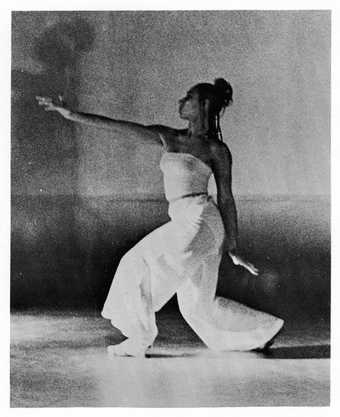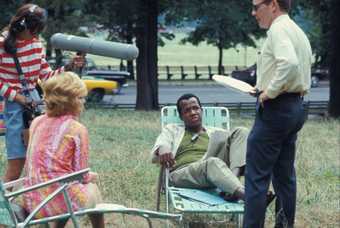This film file is broken and is being removed. Sorry for any inconvenience this causes.
This programme explores complex dialogues between the filmmaker and performers in their works. The choreography of camera movement plays a central role in these works as they move through formal, narrative and symbolic layers. Each film circles around questions of staging, documentation and improvisation as it navigates new ways of both capturing and editing performance.
Julie Dash Four Women 1975, 16mm, colour, sound, 7 min
Four Women captures dancer Linda Martina Young’s choreographic embodiment of four stereotypes of Black female characters described in Nina Simone’s 1966 song of the same name. Moving between intimate close-ups of Young’s movements and gestures, wider shots backlit with gem-coloured floodlights and shots taken from a height, the film showcases its own choreography of lighting, framing and camera movement to the same extent that it documents Young’s performance. Transitions between shots are often momentarily frozen or overlaid on one another, introducing a temporal discontinuity that marks this dialogue between filmmaker and performer as distinctly filmic. Meticulously designed and filmed in beautiful colour, Four Women is both a critical response to Black female stereotypes and one of the most brilliantly realised films about dance.

Julie Dash Four Women 1975, film still. Courtesy the artist and UCLA Film & Television Archive
William Greaves Symbiopsychotaxiplasm: Take One 1968, 35mm transferred to Blu-ray, colour, sound, 75 min
Symbiopsychotaxiplasm: Take One is a breakthrough work of experimental film blending William Greaves' fascination with the creative process involved in acting and with the processes of filmmaking. In what was understood to be a documentary about the making of a low-budget feature about a liberal couple's relationship, Greaves assembled a cast of his Acting Studio students to perform screen tests in New York's Central Park. In addition to his own camera, he hired three sets of film crews to document these takes, the first filming the actors, the second filming the crew and the third filming passersby and any action around the set. As it becomes apparent to the cast and crew that there is little vision for what the feature will actually be, chaos begins to mount on set and the cameras keep rolling. Using split-screen views of multiple perspectives, the resulting meta-documentary reveals precisely the insights and spontaneous energy Greaves was hoping for.

